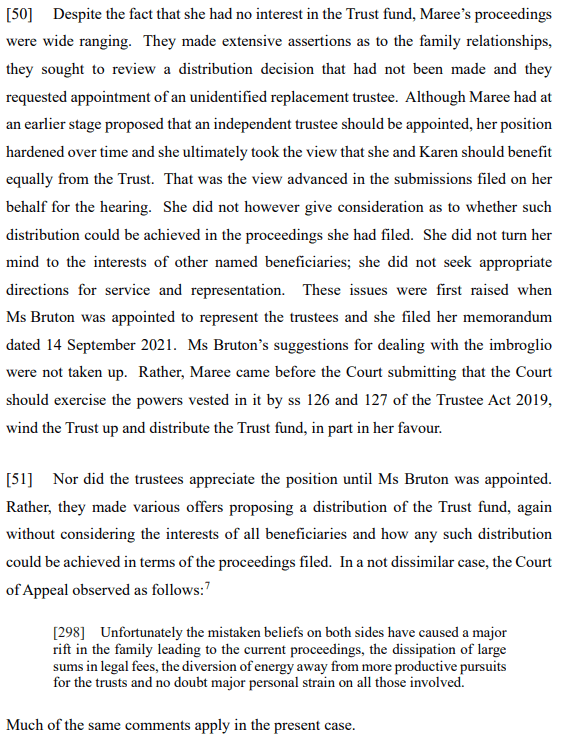Trusts are not legal entities. The “legal face” of a trust is the trustee(s). Trustees are the legal owner of trust assets and it is trustees who are liable for trust debts.
“Liabilities incurred by a trustee in relation to a trust are always the personal liabilities of the trustee … A creditor has a personal right to sue a trustee and to get judgment and make the trustee bankrupt.” See the Supreme Court judgment in Macalister Todd Phillips Bodkins v AMP (emphasis added)
When trustees incur liability it is joint and several. This means that when liability arises, if there is more than one trustee a creditor can pursue any trustee.
However, when a trustee incurs liability, that trustee can then see to recover a proportionate share (and in limited cases all of the cost) from any co-trustees.
Liability of co-trustees
The ability to recover from a co-trustee arises from the concept of “equitable right to contribution”, which enables any parties who share a liability to share equally in the payment of that liability. This reflects the unfairness that would otherwise be the case. The comparative culpability of each trustee is not generally a relevant factor.
Although the normal position is one of equal contribution, there are limited (read exceptional) circumstances where one trustee must fully indemnify another. Where this is the case the trustee who has met a trust liability is entitled to recover the full amount paid from a co-trustee.
The circumstances in which a trustee will be entitled to a full indemnity can be summarised as follows:
- if one of the trustees is a solicitor a co-trustee who has relied on that trustee’s advice can claim an indemnity from the solicitor trustee (the solicitor-trustee rule)
- where a trustee receives a personal benefit from a breach of trust from which the other trustee(s) did not participate, the trustees are entitled to an indemnity from the defaulting trustee. However, the indemnity is limited to the amount of personal benefit received (the personal benefit rule)
- a fraudulent trustee must indemnify any innocent co-trustees – but not any other fraudulent trustees (the fraudulent trustee rule)
- a trustee who is also a beneficiary who benefits from a breach of trust is not entitled to an indemnity from any co-trustees to the extent of the trustee-beneficiary’s interest (the trustee-beneficiary rule). Note that there are divergent views on how the trustee-beneficiary’s beneficial interest is accounted for.
To be entitled to an indemnity a trustee must acted innocently and reasonably and there must have been a breach of trust by a co-trustee.
A trustee will not be entitled to a full indemnity if the trustee has:
- participated in any breach of trust
- abdicated responsibilities and a breach occurred as a result of a co-trustee’s erroneous actions.
Application of principles of indemnity
An example of a situation where a trustee was entitled to be fully indemnified from a co-trustee is the case of Goodwin v Duggan & Ors. Ms Goodwin and her brother were the trustees under a will. Ms Goodwin’s brother misused trust funds for his own benefit. While both trustees were found liable in the first instance, on appeal Ms Goodwin was entitled to be fully indemnified by her brother as he had personally recieved the trust funds and converted them to his own benefit.
References:
- Goodwin v Duggan & Ors [1996] NSWSC 363
Rights of indemnity being used against trustees
In Official Assignee v Smith (Costs) the Official Assignee (in the bankruptcy of the property of Michael Perkins) successfully sought indemnity costs following formal proof of a claim against the trustees of the Bay of Islands Trust. In asserting that claim the Official Assignee stood in the shoes’ of the bankrupt in his capacity as a former trustee of the Trust.
The claim was able to be advanced in reliance on Mr Perkins’ right (as a trustee) to be indemnified from the property of the Trust for proven advances he had made to the Trust.
In attempting to avoid the liability the trustees had to Mr Perkins they were required, pursuant to his indemnity as a trustee to meet his costs on an indemnity (full) basis.
References:
- Official Assignee v Smith (Costs) [2013] NZHC 3275
Costs
Trustees are entitled to reimbursement for reasonably incurred costs. See Butterfield v Public Trust:




“… In my judgment, costs incurred in considering and pursuing a settlement involving a distribution amongst only some of the beneficiaries, without considering the interests of other beneficiaries, were not, considered objectively, reasonably incurred by either Maree or the trustees.”
A careful assessment of what costs should be met from the trust in question followed.
References:
- Butterfield v Public Trust [2017] NZCA 367
- Alexander v Alexander [2021] NZHC 3056
Discussion
No comments yet.